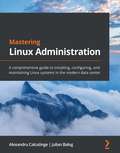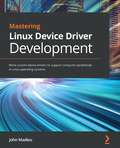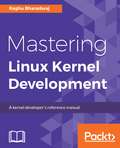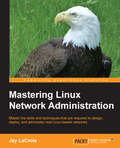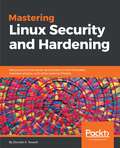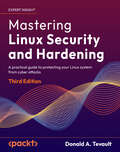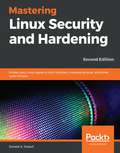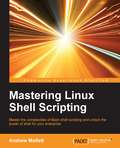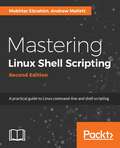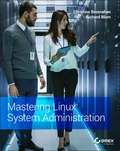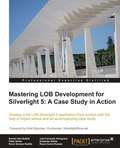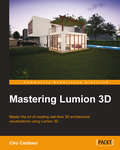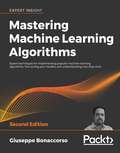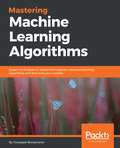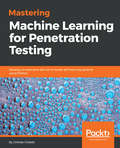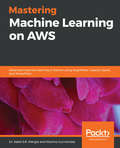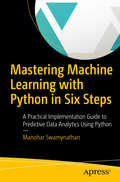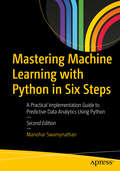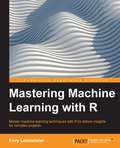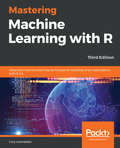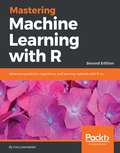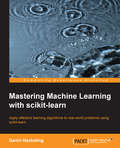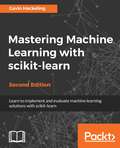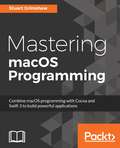- Table View
- List View
Mastering Linux Administration: A comprehensive guide to installing, configuring, and maintaining Linux systems in the modern data center
by Alexandru Calcatinge Julian BalogDevelop advanced skills for working with Linux systems on-premises and in the cloudKey FeaturesBecome proficient in everyday Linux administration tasks by mastering the Linux command line and using automationWork with the Linux filesystem, packages, users, processes, and daemonsDeploy Linux to the cloud with AWS, Azure, and KubernetesBook DescriptionLinux plays a significant role in modern data center management and provides great versatility in deploying and managing your workloads on-premises and in the cloud. This book covers the important topics you need to know about for your everyday Linux administration tasks. The book starts by helping you understand the Linux command line and how to work with files, packages, and filesystems. You'll then begin administering network services and hardening security, and learn about cloud computing, containers, and orchestration. Once you've learned how to work with the command line, you'll explore the essential Linux commands for managing users, processes, and daemons and discover how to secure your Linux environment using application security frameworks and firewall managers. As you advance through the chapters, you'll work with containers, hypervisors, virtual machines, Ansible, and Kubernetes. You'll also learn how to deploy Linux to the cloud using AWS and Azure. By the end of this Linux book, you'll be well-versed with Linux and have mastered everyday administrative tasks using workflows spanning from on-premises to the cloud. If you also find yourself adopting DevOps practices in the process, we'll consider our mission accomplished.What you will learnUnderstand how Linux works and learn basic to advanced Linux administration skillsExplore the most widely used commands for managing the Linux filesystem, network, security, and moreGet to grips with different networking and messaging protocolsFind out how Linux security works and how to configure SELinux, AppArmor, and Linux iptablesWork with virtual machines and containers and understand container orchestration with KubernetesWork with containerized workflows using Docker and KubernetesAutomate your configuration management workloads with AnsibleWho this book is forIf you are a Linux administrator who wants to understand the fundamentals and as well as modern concepts of Linux system administration, this book is for you. Windows System Administrators looking to extend their knowledge to the Linux OS will also benefit from this book.
Mastering Linux Device Drivers Development: Write Custom Device Drivers To Support Computer Peripherals In Linux Operating Systems
by John MadieuThis book is for embedded developers, Linux system engineers, and system programmers who want to explore Linux kernel frameworks and subsystems. C programming skills and a basic understanding of driver development is necessary to get started with this book.
Mastering Linux Kernel Development
by Raghu BharadwajIf you are a Linux developer who has familiarity with Kernel programming, but want to improve your Linux Kernel programming abilities to an expert level then this book is for you. It's a long way to go to be called an expert, but sure it begins here for you
Mastering Linux Network Administration
by Jay LacroixMaster the skills and techniques that are required to design, deploy, and administer real Linux-based networksAbout This BookMaster the art of using Linux and administering network services for enterprise environmentsPerform hands-on activities to reinforce expert-level knowledgeGet full coverage of both the CentOS and Debian systems, including how networking concepts differ for eachWho This Book Is ForMastering Linux Network Administration is recommended for those who already understand the basics of using Linux and networking, and would like to push those skills to a higher level through real-world Linux networking scenarios. Whether you intend to run a home office consisting of Linux nodes or a rollout of a Linux network within your organization, this book is a great fit for those that desire to learn how to manage networked systems with the power of Linux.What You Will LearnInstall and configure the Debian and CentOS systemsSet up and configure file serversAdminister networked nodes remotelyDiscover how to monitor system performance for peak healthConfigure network services such as DNS and DHCPHost HTTP content via ApacheTroubleshoot Linux networking issuesIn DetailLinux is everywhere. Whether you run a home office, a small business, or manage enterprise systems, Linux can empower your network to perform at its very best. Armed with the advanced tools and best practice guidance of this practical guide, you'll be able to mold Linux networks to your will, empowering your systems and their users to take advantage of all that Linux-based networks have to offer.Understand how Linux networks function and get to grips with essential tips and tricks to manage them - whether you're already managing a networks, or even just starting out. With Debian and CentOS as its source, this book will divulge all the details you need to manage a real Linux-based network. With detailed activities and instructions based on real-world scenarios, this book will be your guide to the exciting world of Linux networking.Style and approachThis practical guide will walk you through all the core concepts required to manage real Linux-based networks.
Mastering Linux Security and Hardening: Secure your Linux server and protect it from intruders, malware attacks, and other external threats
by Salman Aftab Donald TevaultA comprehensive guide to mastering the art of preventing your Linux system from getting compromised. Key Features Leverage this guide to confidently deliver a system that reduces the risk of being hacked Perform a number of advanced Linux security techniques such as network service detection, user authentication, controlling special permissions, encrypting file systems, and much more Master the art of securing a Linux environment with this end-to-end practical guide Book Description This book has extensive coverage of techniques that will help prevent attackers from breaching your system, by building a much more secure Linux environment. You will learn various security techniques such as SSH hardening, network service detection, setting up firewalls, encrypting file systems, protecting user accounts, authentication processes, and so on. Moving forward, you will also develop hands-on skills with advanced Linux permissions, access control, special modes, and more. Lastly, this book will also cover best practices and troubleshooting techniques to get your work done efficiently. By the end of this book, you will be confident in delivering a system that will be much harder to compromise. What you will learn Use various techniques to prevent intruders from accessing sensitive data Prevent intruders from planting malware, and detect whether malware has been planted Prevent insiders from accessing data that they aren’t authorized to access Do quick checks to see whether a computer is running network services that it doesn’t need to run Learn security techniques that are common to all Linux distros, and some that are distro-specificWho this book is for If you are a systems administrator or a network engineer interested in making your Linux environment more secure, then this book is for you. Security consultants wanting to enhance their Linux security skills will also benefit from this book. Prior knowledge of Linux is mandatory.
Mastering Linux Security and Hardening: Secure Your Linux Server And Protect It From Intruders, Malware Attacks, And Other External Threats
by Donald A. TevaultFor the past couple of decades, Linux has been extremely popular with systems administrators, for everything from creating networks and servers to automating their entire working environment. However, security has always been the major concern. With not many resources available in the Linux security domain, this book will be an invaluable resource to help you get your Linux systems properly secured.
Mastering Linux Security and Hardening: A practical guide to protecting your Linux system from cyber attacks, 3rd Edition
by Donald A. TevaultGain a firm practical understanding of how to secure your Linux system from intruders, malware attacks, and other cyber threatsPurchase of the print or Kindle book includes a free eBook in PDF format.Key FeaturesDiscover security techniques to prevent malware from infecting a Linux system, and detect itPrevent unauthorized people from breaking into a Linux systemProtect important and sensitive data from being revealed to unauthorized personsBook DescriptionThe third edition of Mastering Linux Security and Hardening is an updated, comprehensive introduction to implementing the latest Linux security measures, using the latest versions of Ubuntu and AlmaLinux.In this new edition, you will learn how to set up a practice lab, create user accounts with appropriate privilege levels, protect sensitive data with permissions settings and encryption, and configure a firewall with the newest firewall technologies. You'll also explore how to use sudo to set up administrative accounts with only the privileges required to do a specific job, and you'll get a peek at the new sudo features that have been added over the past couple of years. You'll also see updated information on how to set up a local certificate authority for both Ubuntu and AlmaLinux, as well as how to automate system auditing. Other important skills that you'll learn include how to automatically harden systems with OpenSCAP, audit systems with auditd, harden the Linux kernel configuration, protect your systems from malware, and perform vulnerability scans of your systems. As a bonus, you'll see how to use Security Onion to set up an Intrusion Detection System.By the end of this new edition, you will confidently be able to set up a Linux server that will be secure and harder for malicious actors to compromise.What you will learnPrevent malicious actors from compromising a production Linux systemLeverage additional features and capabilities of Linux in this new versionUse locked-down home directories and strong passwords to create user accountsPrevent unauthorized people from breaking into a Linux systemConfigure file and directory permissions to protect sensitive dataHarden the Secure Shell service in order to prevent break-ins and data lossApply security templates and set up auditingWho this book is forThis book is for Linux administrators, system administrators, and network engineers interested in securing moderate to complex Linux environments. Security consultants looking to enhance their Linux security skills will also find this book useful. Working experience with the Linux command line and package management is necessary to understand the concepts covered in this book.
Mastering Linux Security and Hardening - Second Edition: Protect your Linux systems from intruders, malware attacks, and other cyber threats, 2nd Edition
by Donald TevaultThis book is for Linux administrators, or aspiring Linux administrators. Readers should know the basics of Linux command-line usage and package management and should be familiar with the process of installing a Linux operating system, either on bare metal or in a virtual machine.
Mastering Linux Shell Scripting
by Andrew MallettMaster the complexities of Bash shell scripting and unlock the power of shell for your enterprise About This Book * Identify the high level steps such as verifying user input, using command lines and conditional statements in creating and executing simple shell scripts * Create and edit dynamic shell scripts to manage complex and repetitive tasks * Learn about scripting in Perl and programming in Python as a BASH scripting alternative with this practical, step-by-step guide Who This Book Is For Mastering Linux Shell Scripting has been written for Linux administrators who want to automate tasks in their daily lives, saving time and effort. You'll need to have command-line experience and be familiar with the tasks that you need to automate. What You Will Learn * Use the type command to identify the order of command evaluation * Create interactive scripts that prompt for user input * Foster menu structures for operators with little command-line experience * Develop scripts that dynamically edit web configuration files to produce a new virtual host * Write scripts that use AWK to search and reports on log files * Draft effective scripts using functions as building blocks, reducing maintenance and build time * Make informed choices by comparing different script languages such as Perl and Python with BASH In Detail Shell scripting is a quick method to prototype a complex application or a problem by automating tasks when working on Linux-based systems. Using both simple one-line commands and command sequences complex problems can be solved with ease, from text processing to backing up sysadmin tools. In this book, you'll discover everything you need to know to master shell scripting and make informed choices about the elements you employ. Get to grips with the fundamentals of creating and running a script in normal mode, and in debug mode. Learn about various conditional statements' code snippets, and realize the power of repetition and loops in your shell script. Implement functions and edit files using the Stream Editor, script in Perl, program in Python - as well as complete coverage of other scripting languages to ensure you can choose the best tool for your project. Style and approach The book will capture your attention and keep you engaged with the simplicity and clarity of each explanation. Every step is accompanied with screen captures so you can cross-check the results before moving on.
Mastering Linux Shell Scripting,: A practical guide to Linux command-line, Bash scripting, and Shell programming, 2nd Edition
by Andrew Mallett Mokhtar EbrahimMaster the complexities of Bash shell scripting and unlock the power of shell for your enterpriseKey FeaturesIdentify high-level steps such as verifying user inputUsing the command line and conditional statements in creating/executing simple shell scriptsCreate and edit dynamic shell scripts to manage complex and repetitive tasksLeverage the command-line to bypass GUI and automate common tasksBook DescriptionIn this book, you’ll discover everything you need to know to master shell scripting and make informed choices about the elements you employ.Grab your favorite editor and start writing your best Bash scripts step by step. Get to grips with the fundamentals of creating and running a script in normal mode, and in debug mode. Learn about various conditional statements' code snippets, and realize the power of repetition and loops in your shell script. You will also learn to write complex shell scripts. This book will also deep dive into file system administration, directories, and system administration like networking, process management, user authentications, and package installation and regular expressions. Towards the end of the book, you will learn how to use Python as a BASH Scripting alternative. By the end of this book, you will know shell scripts at the snap of your fingers and will be able to automate and communicate with your system with keyboard expressions.What you will learnMake, execute, and debug your first Bash scriptCreate interactive scripts that prompt for user inputFoster menu structures for operators with little command-line experienceDevelop scripts that dynamically edit web configuration files to produce a new virtual host Write scripts that use AWK to search and reports on log filesDraft effective scripts using functions as building blocks, reducing maintenance and build timeMake informed choices by comparing different script languages such as Python with BASHWho this book is forIf you are a Linux administrator or a system administrator and are interested in automating tasks in your daily lives, saving time and effort, this book is for you. Basic shell scripting and command-line experience will be required. Familiarity with the tasks you need to automate will be helpful.
Mastering Linux System Administration
by Richard Blum Christine BresnahanAchieve Linux system administration mastery with time-tested and proven techniques In Mastering Linux System Administration, Linux experts and system administrators Christine Bresnahan and Richard Blum deliver a comprehensive roadmap to go from Linux beginner to expert Linux system administrator with a learning-by-doing approach. Organized by do-it-yourself tasks, the book includes instructor materials like a sample syllabus, additional review questions, and slide decks. Amongst the practical applications of the Linux operating system included within, you’ll find detailed and easy-to-follow instruction on: Installing Linux servers, understanding the boot and initialization processes, managing hardware, and working with networks Accessing the Linux command line, working with the virtual directory structure, and creating shell scripts to automate administrative tasks Managing Linux user accounts, system security, web and database servers, and virtualization environments Perfect for entry-level Linux system administrators, as well as system administrators familiar with Windows, Mac, NetWare, or other UNIX systems, Mastering Linux System Administration is a must-read guide to manage and secure Linux servers.
Mastering LOB Development for Silverlight 5: A Case Study in Action
by Pablo Nunez Navarro Jose Fernando Almoguera Rocío Serrano Braulio Díez Sebastian StehleThis highly practical, expert level tutorial teaches you to build a Line of Business application with the aid of a case study which gradually builds throughout the book. It also includes a jumpstart chapter for developers coming from other technologies. If you already have a firm grasp of Silverlight development and are keen to advance your specialist knowledge of Line of Business (LOB) application development, then Expert Line of Business Application Development for Silverlight 5: Quick Start Guide is for you. If you are a developer with experience of other technologies, you may also find this book useful.
Mastering Lumion 3D
by Ciro CardosoThis book is designed for all levels of Lumion users; from beginner to advanced, you will find useful insights and professional techniques to improve and develop your skills in order to fully control and master Lumion.
Mastering Machine Learning Algorithms: Expert techniques for implementing popular machine learning algorithms, fine-tuning your models, and understanding how they work, 2nd Edition
by Giuseppe BonaccorsoUpdated and revised second edition of the bestselling guide to exploring and mastering the most important algorithms for solving complex machine learning problems Key Features Updated to include new algorithms and techniques Code updated to Python 3.8 & TensorFlow 2.x New coverage of regression analysis, time series analysis, deep learning models, and cutting-edge applications Book Description Mastering Machine Learning Algorithms, Second Edition helps you harness the real power of machine learning algorithms in order to implement smarter ways of meeting today's overwhelming data needs. This newly updated and revised guide will help you master algorithms used widely in semi-supervised learning, reinforcement learning, supervised learning, and unsupervised learning domains. You will use all the modern libraries from the Python ecosystem – including NumPy and Keras – to extract features from varied complexities of data. Ranging from Bayesian models to the Markov chain Monte Carlo algorithm to Hidden Markov models, this machine learning book teaches you how to extract features from your dataset, perform complex dimensionality reduction, and train supervised and semi-supervised models by making use of Python-based libraries such as scikit-learn. You will also discover practical applications for complex techniques such as maximum likelihood estimation, Hebbian learning, and ensemble learning, and how to use TensorFlow 2.x to train effective deep neural networks. By the end of this book, you will be ready to implement and solve end-to-end machine learning problems and use case scenarios. What you will learn Understand the characteristics of a machine learning algorithm Implement algorithms from supervised, semi-supervised, unsupervised, and RL domains Learn how regression works in time-series analysis and risk prediction Create, model, and train complex probabilistic models Cluster high-dimensional data and evaluate model accuracy Discover how artificial neural networks work – train, optimize, and validate them Work with autoencoders, Hebbian networks, and GANs Who this book is for This book is for data science professionals who want to delve into complex ML algorithms to understand how various machine learning models can be built. Knowledge of Python programming is required.
Mastering Machine Learning Algorithms: Expert techniques to implement popular machine learning algorithms and fine-tune your models
by Giuseppe Bonaccorso c/o QuandooExplore and master the most important algorithms for solving complex machine learning problems.Key FeaturesDiscover high-performing machine learning algorithms and understand how they work in depth. One-stop solution to mastering supervised, unsupervised, and semi-supervised machine learning algorithms and their implementation. Master concepts related to algorithm tuning, parameter optimization, and moreBook DescriptionMachine learning is a subset of AI that aims to make modern-day computer systems smarter and more intelligent. The real power of machine learning resides in its algorithms, which make even the most difficult things capable of being handled by machines. However, with the advancement in the technology and requirements of data, machines will have to be smarter than they are today to meet the overwhelming data needs; mastering these algorithms and using them optimally is the need of the hour. Mastering Machine Learning Algorithms is your complete guide to quickly getting to grips with popular machine learning algorithms. You will be introduced to the most widely used algorithms in supervised, unsupervised, and semi-supervised machine learning, and will learn how to use them in the best possible manner. Ranging from Bayesian models to the MCMC algorithm to Hidden Markov models, this book will teach you how to extract features from your dataset and perform dimensionality reduction by making use of Python-based libraries such as scikit-learn. You will also learn how to use Keras and TensorFlow to train effective neural networks.If you are looking for a single resource to study, implement, and solve end-to-end machine learning problems and use-cases, this is the book you need.What you will learnExplore how a ML model can be trained, optimized, and evaluatedUnderstand how to create and learn static and dynamic probabilistic modelsSuccessfully cluster high-dimensional data and evaluate model accuracyDiscover how artificial neural networks work and how to train, optimize, and validate themWork with Autoencoders and Generative Adversarial NetworksApply label spreading and propagation to large datasetsExplore the most important Reinforcement Learning techniquesWho this book is forThis book is an ideal and relevant source of content for data science professionals who want to delve into complex machine learning algorithms, calibrate models, and improve the predictions of the trained model. A basic knowledge of machine learning is preferred to get the best out of this guide.
Mastering Machine Learning for Penetration Testing: Develop an extensive skill set to break self-learning systems using Python
by Chiheb ChebbiBecome a master at penetration testing using machine learning with PythonKey Features Identify ambiguities and breach intelligent security systems Perform unique cyber attacks to breach robust systems Learn to leverage machine learning algorithmsBook DescriptionCyber security is crucial for both businesses and individuals. As systems are getting smarter, we now see machine learning interrupting computer security. With the adoption of machine learning in upcoming security products, it’s important for pentesters and security researchers to understand how these systems work, and to breach them for testing purposes. This book begins with the basics of machine learning and the algorithms used to build robust systems. Once you’ve gained a fair understanding of how security products leverage machine learning, you'll dive into the core concepts of breaching such systems. Through practical use cases, you’ll see how to find loopholes and surpass a self-learning security system. As you make your way through the chapters, you’ll focus on topics such as network intrusion detection and AV and IDS evasion. We’ll also cover the best practices when identifying ambiguities, and extensive techniques to breach an intelligent system.By the end of this book, you will be well-versed with identifying loopholes in a self-learning security system and will be able to efficiently breach a machine learning system.What you will learnTake an in-depth look at machine learningGet to know natural language processing (NLP)Understand malware feature engineeringBuild generative adversarial networks using Python librariesWork on threat hunting with machine learning and the ELK stackExplore the best practices for machine learningWho this book is forThis book is for pen testers and security professionals who are interested in learning techniques to break an intelligent security system. Basic knowledge of Python is needed, but no prior knowledge of machine learning is necessary.
Mastering Machine Learning on AWS: Advanced machine learning in Python using SageMaker, Apache Spark, and TensorFlow
by Dr. Saket Mengle Maximo GurmendezGain expertise in ML techniques with AWS to create interactive apps using SageMaker, Apache Spark, and TensorFlow.Key FeaturesBuild machine learning apps on Amazon Web Services (AWS) using SageMaker, Apache Spark and TensorFlowLearn model optimization, and understand how to scale your models using simple and secure APIsDevelop, train, tune and deploy neural network models to accelerate model performance in the cloudBook DescriptionAWS is constantly driving new innovations that empower data scientists to explore a variety of machine learning (ML) cloud services. This book is your comprehensive reference for learning and implementing advanced ML algorithms in AWS cloud.As you go through the chapters, you’ll gain insights into how these algorithms can be trained, tuned and deployed in AWS using Apache Spark on Elastic Map Reduce (EMR), SageMaker, and TensorFlow. While you focus on algorithms such as XGBoost, linear models, factorization machines, and deep nets, the book will also provide you with an overview of AWS as well as detailed practical applications that will help you solve real-world problems. Every practical application includes a series of companion notebooks with all the necessary code to run on AWS. In the next few chapters, you will learn to use SageMaker and EMR Notebooks to perform a range of tasks, right from smart analytics, and predictive modeling, through to sentiment analysis. By the end of this book, you will be equipped with the skills you need to effectively handle machine learning projects and implement and evaluate algorithms on AWS.What you will learnManage AI workflows by using AWS cloud to deploy services that feed smart data productsUse SageMaker services to create recommendation modelsScale model training and deployment using Apache Spark on EMRUnderstand how to cluster big data through EMR and seamlessly integrate it with SageMakerBuild deep learning models on AWS using TensorFlow and deploy them as servicesEnhance your apps by combining Apache Spark and Amazon SageMakerWho this book is forThis book is for data scientists, machine learning developers, deep learning enthusiasts and AWS users who want to build advanced models and smart applications on the cloud using AWS and its integration services. Some understanding of machine learning concepts, Python programming and AWS will be beneficial.
Mastering Machine Learning with Python in Six Steps
by Manohar SwamynathanMaster machine learning with Python in six steps and explore fundamental to advanced topics, all designed to make you a worthy practitioner. This book's approach is based on the "Six degrees of separation" theory, which states that everyone and everything is a maximum of six steps away. Mastering Machine Learning with Python in Six Steps presents each topic in two parts: theoretical concepts and practical implementation using suitable Python packages. You'll learn the fundamentals of Python programming language, machine learning history, evolution, and the system development frameworks. Key data mining/analysis concepts, such as feature dimension reduction, regression, time series forecasting and their efficient implementation in Scikit-learn are also covered. Finally, you'll explore advanced text mining techniques, neural networks and deep learning techniques, and their implementation. All the code presented in the book will be available in the form of iPython notebooks to enable you to try out these examples and extend them to your advantage. What You'll Learn Examine the fundamentals of Python programming language Review machine Learning history and evolution Understand machine learning system development frameworks Implement supervised/unsupervised/reinforcement learning techniques with examples Explore fundamental to advanced text mining techniques Implement various deep learning frameworks Who This Book Is For Python developers or data engineers looking to expand their knowledge or career into machine learning area. Non-Python (R, SAS, SPSS, Matlab or any other language) machine learning practitioners looking to expand their implementation skills in Python. Novice machine learning practitioners looking to learn advanced topics, such as hyperparameter tuning, various ensemble techniques, natural language processing (NLP), deep learning, and basics of reinforcement learning.
Mastering Machine Learning with Python in Six Steps: A Practical Implementation Guide to Predictive Data Analytics Using Python
by Manohar SwamynathanExplore fundamental to advanced Python 3 topics in six steps, all designed to make you a worthy practitioner. This updated version’s approach is based on the “six degrees of separation” theory, which states that everyone and everything is a maximum of six steps away and presents each topic in two parts: theoretical concepts and practical implementation using suitable Python 3 packages.You’ll start with the fundamentals of Python 3 programming language, machine learning history, evolution, and the system development frameworks. Key data mining/analysis concepts, such as exploratory analysis, feature dimension reduction, regressions, time series forecasting and their efficient implementation in Scikit-learn are covered as well. You’ll also learn commonly used model diagnostic and tuning techniques. These include optimal probability cutoff point for class creation, variance, bias, bagging, boosting, ensemble voting, grid search, random search, Bayesian optimization, and the noise reduction technique for IoT data. Finally, you’ll review advanced text mining techniques, recommender systems, neural networks, deep learning, reinforcement learning techniques and their implementation. All the code presented in the book will be available in the form of iPython notebooks to enable you to try out these examples and extend them to your advantage.What You'll LearnUnderstand machine learning development and frameworksAssess model diagnosis and tuning in machine learningExamine text mining, natuarl language processing (NLP), and recommender systemsReview reinforcement learning and CNNWho This Book Is ForPython developers, data engineers, and machine learning engineers looking to expand their knowledge or career into machine learning area.
Mastering Machine Learning with R
by Cory LeismesterIf you want to learn how to use R's machine learning capabilities to solve complex business problems, then this book is for you. Some experience with R and a working knowledge of basic statistical or machine learning will prove helpful.
Mastering Machine Learning with R: Advanced machine learning techniques for building smart applications with R 3.5, 3rd Edition
by Cory LesmeisterStay updated with expert techniques for solving data analytics and machine learning challenges and gain insights from complex projects and power up your applications Key Features Build independent machine learning (ML) systems leveraging the best features of R 3.5 Understand and apply different machine learning techniques using real-world examples Use methods such as multi-class classification, regression, and clustering Book Description Given the growing popularity of the R-zerocost statistical programming environment, there has never been a better time to start applying ML to your data. This book will teach you advanced techniques in ML ,using? the latest code in R 3.5. You will delve into various complex features of supervised learning, unsupervised learning, and reinforcement learning algorithms to design efficient and powerful ML models. This newly updated edition is packed with fresh examples covering a range of tasks from different domains. Mastering Machine Learning with R starts by showing you how to quickly manipulate data and prepare it for analysis. You will explore simple and complex models and understand how to compare them. You'll also learn to use the latest library support, such as TensorFlow and Keras-R, for performing advanced computations. Additionally, you'll explore complex topics, such as natural language processing (NLP), time series analysis, and clustering, which will further refine your skills in developing applications. Each chapter will help you implement advanced ML algorithms using real-world examples. You'll even be introduced to reinforcement learning, along with its various use cases and models. In the concluding chapters, you'll get a glimpse into how some of these blackbox models can be diagnosed and understood. By the end of this book, you'll be equipped with the skills to deploy ML techniques in your own projects or at work. What you will learn Prepare data for machine learning methods with ease Understand how to write production-ready code and package it for use Produce simple and effective data visualizations for improved insights Master advanced methods, such as Boosted Trees and deep neural networks Use natural language processing to extract insights in relation to text Implement tree-based classifiers, including Random Forest and Boosted Tree Who this book is for This book is for data science professionals, machine learning engineers, or anyone who is looking for the ideal guide to help them implement advanced machine learning algorithms. The book will help you take your skills to the next level and advance further in this field. Working knowledge of machine learning with R is mandatory.
Mastering Machine Learning with R - Second Edition
by Cory LesmeisterMaster machine learning techniques with R to deliver insights in complex projects About This Book • Understand and apply machine learning methods using an extensive set of R packages such as XGBOOST • Understand the benefits and potential pitfalls of using machine learning methods such as Multi-Class Classification and Unsupervised Learning • Implement advanced concepts in machine learning with this example-rich guide Who This Book Is For This book is for data science professionals, data analysts, or anyone with a working knowledge of machine learning, with R who now want to take their skills to the next level and become an expert in the field. What You Will Learn • Gain deep insights into the application of machine learning tools in the industry • Manipulate data in R efficiently to prepare it for analysis • Master the skill of recognizing techniques for effective visualization of data • Understand why and how to create test and training data sets for analysis • Master fundamental learning methods such as linear and logistic regression • Comprehend advanced learning methods such as support vector machines • Learn how to use R in a cloud service such as Amazon In Detail This book will teach you advanced techniques in machine learning with the latest code in R 3.3.2. You will delve into statistical learning theory and supervised learning; design efficient algorithms; learn about creating Recommendation Engines; use multi-class classification and deep learning; and more. You will explore, in depth, topics such as data mining, classification, clustering, regression, predictive modeling, anomaly detection, boosted trees with XGBOOST, and more. More than just knowing the outcome, you'll understand how these concepts work and what they do. With a slow learning curve on topics such as neural networks, you will explore deep learning, and more. By the end of this book, you will be able to perform machine learning with R in the cloud using AWS in various scenarios with different datasets. Style and approach The book delivers practical and real-world solutions to problems and a variety of tasks such as complex recommendation systems. By the end of this book, you will have gained expertise in performing R machine learning and will be able to build complex machine learning projects using R and its packages.
Mastering Machine Learning with scikit-learn
by Gavin HackelingIf you are a software developer who wants to learn how machine learning models work and how to apply them effectively, this book is for you. Familiarity with machine learning fundamentals and Python will be helpful, but is not essential.
Mastering Machine Learning with scikit-learn - Second Edition
by Gavin HackelingUse scikit-learn to apply machine learning to real-world problems About This Book • Master popular machine learning models including k-nearest neighbors, random forests, logistic regression, k-means, naive Bayes, and artificial neural networks • Learn how to build and evaluate performance of efficient models using scikit-learn • Practical guide to master your basics and learn from real life applications of machine learning Who This Book Is For This book is intended for software engineers who want to understand how common machine learning algorithms work and develop an intuition for how to use them, and for data scientists who want to learn about the scikit-learn API. Familiarity with machine learning fundamentals and Python are helpful, but not required. What You Will Learn • Review fundamental concepts such as bias and variance • Extract features from categorical variables, text, and images • Predict the values of continuous variables using linear regression and K Nearest Neighbors • Classify documents and images using logistic regression and support vector machines • Create ensembles of estimators using bagging and boosting techniques • Discover hidden structures in data using K-Means clustering • Evaluate the performance of machine learning systems in common tasks In Detail Machine learning is the buzzword bringing computer science and statistics together to build smart and efficient models. Using powerful algorithms and techniques offered by machine learning you can automate any analytical model. This book examines a variety of machine learning models including popular machine learning algorithms such as k-nearest neighbors, logistic regression, naive Bayes, k-means, decision trees, and artificial neural networks. It discusses data preprocessing, hyperparameter optimization, and ensemble methods. You will build systems that classify documents, recognize images, detect ads, and more. You will learn to use scikit-learn's API to extract features from categorical variables, text and images; evaluate model performance, and develop an intuition for how to improve your model's performance. By the end of this book, you will master all required concepts of scikit-learn to build efficient models at work to carry out advanced tasks with the practical approach. Style and approach This book is motivated by the belief that you do not understand something until you can describe it simply. Work through toy problems to develop your understanding of the learning algorithms and models, then apply your learnings to real-life problems.
Mastering macOS Programming
by Stuart GrimshawThis book is for developers who have some experience with macOS and want to take their skills to next level by unlocking the full potential of latest version of macOS with Swift 3 to build impressive applications. Basic knowledge of Swift will be beneficial but is not required.
